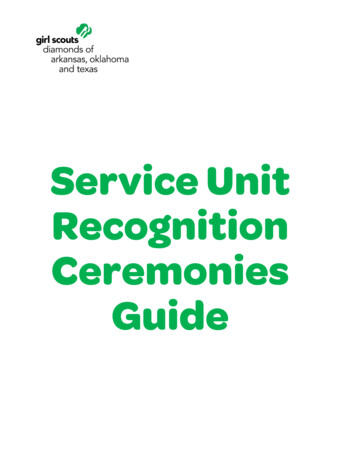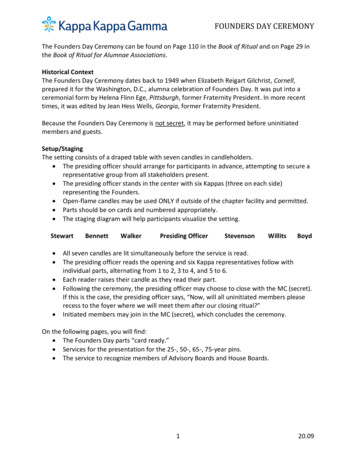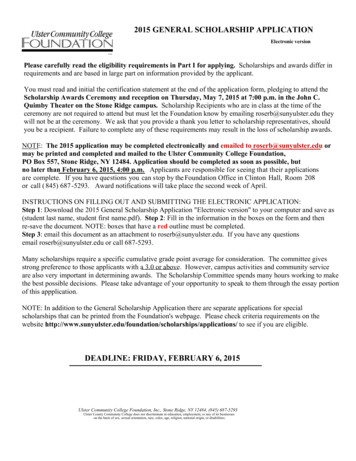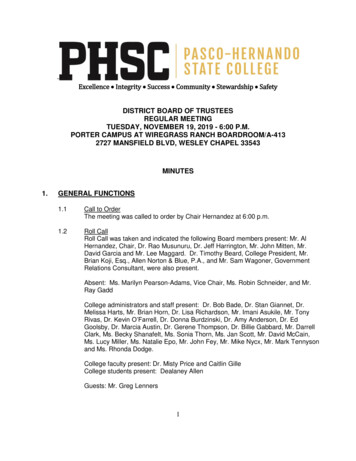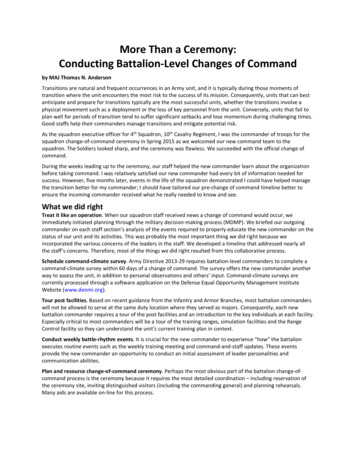
Transcription
More Than a Ceremony:Conducting Battalion-Level Changes of Commandby MAJ Thomas N. AndersonTransitions are natural and frequent occurrences in an Army unit, and it is typically during those moments oftransition where the unit encounters the most risk to the success of its mission. Consequently, units that can bestanticipate and prepare for transitions typically are the most successful units, whether the transitions involve aphysical movement such as a deployment or the loss of key personnel from the unit. Conversely, units that fail toplan well for periods of transition tend to suffer significant setbacks and lose momentum during challenging times.Good staffs help their commanders manage transitions and mitigate potential risk.As the squadron executive officer for 4th Squadron, 10th Cavalry Regiment, I was the commander of troops for thesquadron change-of-command ceremony in Spring 2015 as we welcomed our new command team to thesquadron. The Soldiers looked sharp, and the ceremony was flawless. We succeeded with the official change ofcommand.During the weeks leading up to the ceremony, our staff helped the new commander learn about the organizationbefore taking command. I was relatively satisfied our new commander had every bit of information needed forsuccess. However, five months later, events in the life of the squadron demonstrated I could have helped managethe transition better for my commander; I should have tailored our pre-change of command timeline better toensure the incoming commander received what he really needed to know and see.What we did rightTreat it like an operation. When our squadron staff received news a change of command would occur, weimmediately initiated planning through the military decision-making process (MDMP). We briefed our outgoingcommander on each staff section’s analysis of the events required to properly educate the new commander on thestatus of our unit and its activities. This was probably the most important thing we did right because weincorporated the various concerns of the leaders in the staff. We developed a timeline that addressed nearly allthe staff’s concerns. Therefore, most of the things we did right resulted from this collaborative process.Schedule command-climate survey. Army Directive 2013-29 requires battalion-level commanders to complete acommand-climate survey within 60 days of a change of command. The survey offers the new commander anotherway to assess the unit, in addition to personal observations and others’ input. Command-climate surveys arecurrently processed through a software application on the Defense Equal Opportunity Management InstituteWebsite (www.deomi.org).Tour post facilities. Based on recent guidance from the Infantry and Armor Branches, most battalion commanderswill not be allowed to serve at the same duty location where they served as majors. Consequently, each newbattalion commander requires a tour of the post facilities and an introduction to the key individuals at each facility.Especially critical to most commanders will be a tour of the training ranges, simulation facilities and the RangeControl facility so they can understand the unit’s current training plan in context.Conduct weekly battle-rhythm events. It is crucial for the new commander to experience “how” the battalionexecutes routine events such as the weekly training meeting and command-and-staff updates. These eventsprovide the new commander an opportunity to conduct an initial assessment of leader personalities andcommunication abilities.Plan and resource change-of-command ceremony. Perhaps the most obvious part of the battalion change-ofcommand process is the ceremony because it requires the most detailed coordination – including reservation ofthe ceremony site, inviting distinguished visitors (including the commanding general) and planning rehearsals.Many aids are available on-line for this process.
Schedule counseling with brigade commander. Once the new commander begins in-processing, it is critical toschedule initial counseling for him/her with the brigade commander. Accomplishing this early in the processensures the new commander can nest initial guidance for subordinates with the brigade commander’s guidance.Conduct Sexual Harassment/Assault Response and Prevention (SHARP) and Equal Opportunity (EO) programs inbriefs. “SHARP remains a top priority for both the Secretary of the Army and the Chief of Staff of the Army,”1 so weensured the new commander understood the status of the program within the battalion. This included briefingsabout ongoing cases and the training history of the subordinate units. Also, our EO program leader briefed the newcommander in a similar manner. This interaction with the SHARP and EO leads for our squadron ensured the newcommander knew who to go to if issues developed that required immediate action in these areas.Review non-deployable roster. With the current drawdown in the Army, every Soldier who can deploy matters tothe unit’s ability to accomplish its deployed mission. This is especially true now because the Army will no longer fillour ranks at more than 100 percent strength as it did at the height of the wars in Iraq and Afghanistan. At thesquadron level, our unit conducts a review, with the squadron physician’s assistant and the subordinatecommanders present, once every two weeks to track the status of all non-deployable Soldiers within the squadron.Facilitating the new commander’s understanding of the specific details of the unit’s non-deployable personnelprovides an accurate picture of what the battalion’s assigned strength really means when coupled with the nondeployable roster.Update battalion policy letters. Outside of “command philosophy,” most policy letters should not be alteredsignificantly until the new commander has a chance to evaluate the unit. Soldiers need to be aware the policies ofthe former commander remain in effect until the new commander changes them. However, posted policy lettersstill bearing the previous commander’s signature weeks after a change of command reflect poorly on theorganization’s staff.Tour barracks and motorpool. The new commander needs to know where the Soldiers primarily work and live tounderstand the unit. Therefore touring the barracks before assuming command lets the Soldiers know the newcommander cares about their quality of life. Inspecting the motorpool allows the new commander to check theunit’s safety conditions and assess how the unit takes care of its vehicles and equipment.What we missedReceive introductions from staff sections / specialties. Although we planned aggressively for each staff section toindividually brief the new commander on the unit’s personnel, duties and responsibilities, time constraintsresulted in our failure to have all staff sections brief the new commander. This could have biased the newcommander toward particular staff sections (positively or negatively), and it could also have created a lessaccurate understanding of all the staff’s activities.Receive introductions from subordinate units at their headquarters. We were successful in having severalsubordinate unit commanders brief the new commander on their teams at their own headquarters (which allowedthe new commander to see the subordinate commanders in their daily environments). Unfortunately, not all thesubordinate commanders were able to do so. In this sense, the staff failed to prioritize the new commander’scalendar to enable one of the most important events to happen at the subordinate-unit level, a properintroduction to the new commander.Meet the battalion’s families. Because our unit deployed immediately after the change-of-command ceremony(within one week), there was not enough time for the squadron commander to meet with the families withouttaking time away from their last week with their Soldiers prior to the deployment. Without the impendingdeployment, a “unit family day” after the change-of-command ceremony would have been an appropriate way tointroduce the families to the new commander.Meet family-readiness group (FRG) leaders. We also failed to provide the new commander an opportunity tomeet FRG leaders from the subordinate units. This would have made the squadron more effective during itssubsequent deployment because the new commander would have heard directly from the FRG leaders about thestatus of their unit’s FRG program. This would have helped the commander better direct assets to support theunits with respect to the programs that support families at home station.
Counsel subordinates and view counseling of subordinates. Although we scheduled time for the new commanderto counsel his subordinate commanders and field-grade officers individually, our staff did not allocate time for thenew commander to inspect and review the counseling of subordinate leaders. This would have shown the newcommander whether or not counseling was being conducted to standard at the lower echelons. It would have alsoprovided insight into which subordinates had good leadership-development plans within their organizations.View subordinate units’ property-accountability procedures. At the troop and company levels, changes ofcommand focus significantly on property accountability and the transfer of property from one commander toanother. During a battalion change of command, there is no property book transfer, but property accountabilityprocedures are still vitally important. New commanders must be given the opportunity to inspect subordinate-unitproperty-accountability procedures and paperwork because company-level property concerns can quickly becomebattalion-level problems through the initiation of Financial Liability Investigation of Property Loss procedures.Order more battalion coins. Battalion commanders are authorized the purchase of unit coins to recognizeexcellence and reward high-performing individuals. More often than not, though, an outgoing commander willwish to reward the Soldiers and leaders he/she worked with during the preceding years by giving out those coinsuntil they are exhausted. Therefore, a good staff needs to order new coins prior to the new commander takingcommand to allow for the continued recognition and reward of excellence without interruption.Schedule visits with other battalion commanders.2 The new commander needs to meet subordinates, superiorsand future peers. Allocating time for the new commander to meet with peers is particularly important. The otherbattalion commanders represent a new commander’s peer set for the next several years, and getting acquaintedwith the more experienced battalion commanders allows the new commander to be able to reach out and askquestions of peers during the crucial first two or three weeks in command.Schedule visit with brigade command sergeant major.3 No one has a more important relationship with thebrigade commander than the brigade command sergeant major, so meeting with him/her provides the newsquadron (battalion) commander good insight into the brigade command team’s real concerns. The brigadecommand sergeant major can also provide important feedback to the new commander about the unit’s reputationand the state of morale and training in the ranks.Receive overview of the Better Opportunities for Single Soldiers (BOSS) program.4 The battalion’s families areimportant for the new commander to get to know, but taking care of single Soldiers should also be a priority forthe new commander. Therefore it’s important for the staff to allocate time for the battalion’s BOSS representativeto provide a program overview to the new commander. This overview provides key perspective on the concerns ofthe unit’s single Soldiers.ConclusionIn conducting research for this article, I observed there is no widely used checklist for the execution of a battalionlevel change of command (many books and checklists exist for company-level changes of command). Mostresources focus only on the proper procedures for conducting the battalion-level change-of-command ceremonyitself. It is my hope that this article, and the checklist provided, can help future battalion and squadron staffsbetter prepare to conduct the whole change of command well, not just the ceremony.New battalion commander’s checklistStaff conducts MDMP on change-of-command “operation”Schedule command-climate surveyTour post facilities (Range Control, simulations center, etc.)Experience all weekly battle-rhythm eventsReceive introduction/brief from all shops/specialtiesReceive introduction/briefs from all subordinate units at their headquartersGo/No-go
Staff plans/resources change-of-command ceremonyMeet battalion familiesMeet FRG leadersCounsel subordinates and view counseling of subordinatesCounsel subordinate units’ property-accountability proceduresSchedule new commander counseling with brigade commanderReceive SHARP/EO programs in-briefsReceive overview of non-deployable rosterUpdate battalion policy lettersOrder more battalion coinsSchedule visits with other battalion commandersSchedule visit with brigade command sergeant majorTour barracks and motorpoolReceive overview of BOSS programFigure 1. Battalion-level change-of-command ceremony checklist.MAJ Thomas Anderson serves as the squadron executive officer for 4th Squadron, 10th Cavalry Regiment, 3rdArmored Brigade Combat Team, 4th Infantry Division. Other assignments include squadron executive officer, 4-10Cav, Fort Carson, CO; squadron S-3 (operations officer), 4-10 Cav, Fort Carson; instructor, U.S. Military Academy,West Point, NY; and Stryker company commander, 1st Battalion, 5th Infantry Regiment, Fort Wainwright, AK. Hisprofessional military education includes Command and General Staff College and Infantry Captain’s Career Course.He holds a master’s of arts degree in English (rhetoric and composition) from Old Dominion University and abachelor’s of science degree in international relations from the U.S. Military Academy.Notes“Army establishes U.S. Army Sexual Harassment/Assault Response and Prevention Academy,” Washington, DC, Sept. 8, 2014,www.army.mil.2 Thomas P. Gannon, editor, The Battalion Commander’s Handbook, Carlisle Barracks, PA: U.S. Army War College, 1996,available at andbook.htm.3 Ibid.4 Ibid.1
Figure 2. LTC Chad R. Foster and CSM Dean J. Lockhart case the unit’s colors during the deployment ceremonyfor 4th Squadron, 10th Cavalry Regiment, at Fort Carson, CO, May 7, 2015. (Photo by SPC Analaura Polanco)Figure 3. MG Paul LaCamera passes the unit colors to LTC Chad R. Foster during the change-of-commandceremony for 4th Squadron, 10th Cavalry Regiment, at Fort Carson, CO, May 7, 2015. (Photo by SPC AnalauraPolanco)
deployment, a “unit family day” after the change-of-command ceremony would have been an appropriate way to introduce the families to the new commander. Meet family-readiness group (FRG) leaders. We also failed to provide the new commander an opportunity to meet FRG leaders from thesubo
